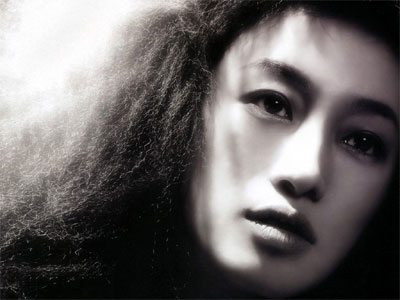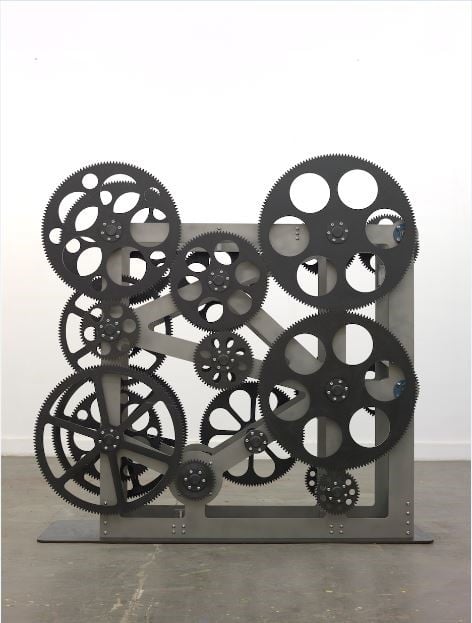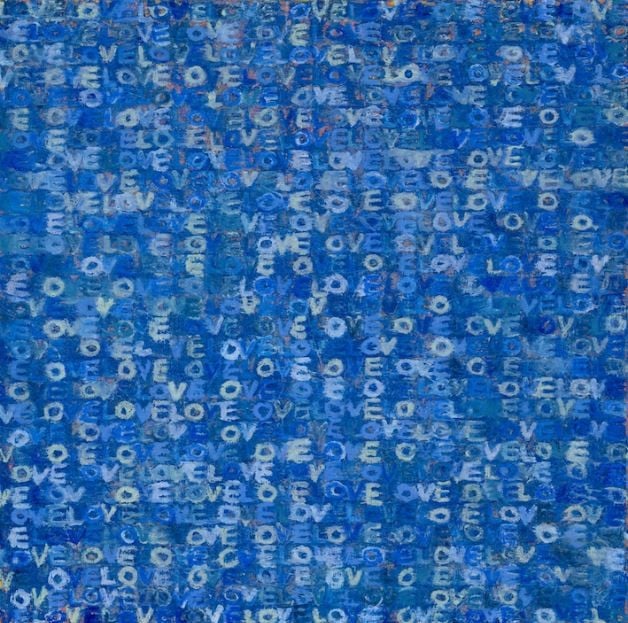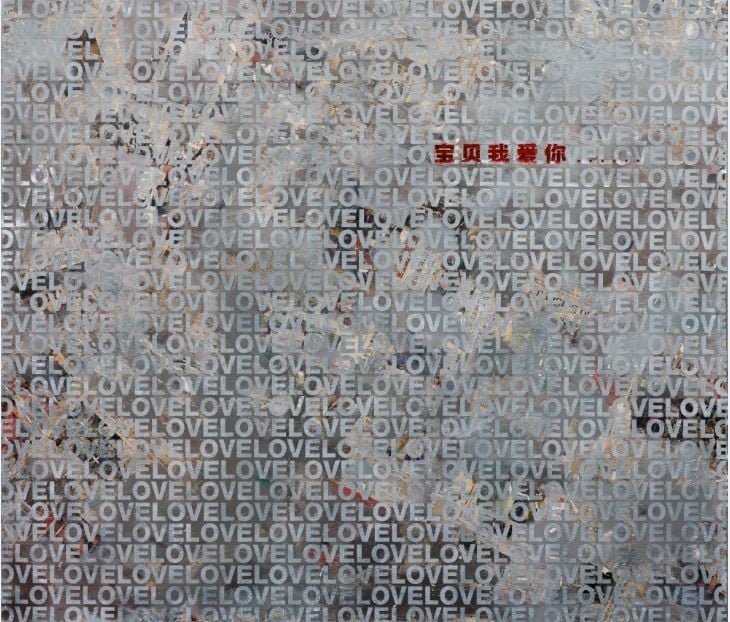Art & Exhibitions
Ai Jing on the Art of (Un)Gainful Employment–Being an Artist
The Chinese pop star says nature and love inspire her work.

The Chinese pop star says nature and love inspire her work.

Sam Gaskin


Ai Jing My Mom and My Hometown (2012). Image courtesy of Ai Jing Studio.
There are more dogs than people wandering the dusty lanes near 798 on a sleepy Beijing Saturday near dusk.
Yet Ai Jing (艾敬) is busy painting when I arrive at her studio, a warehouse-sized space currently dominated by large round canvases. Ai describes the studio hours she keeps as those of a white-collar worker—she works morning till night, in sync with the daylight that inspires many of her color choices, including gold and lush floral hues.
But even white-collar workers take weekends off. “I’m always chasing time,” she says.
Born in Shenyang, near the North Korean border, in 1969, Ai worked diligently from a young age. She had a private singing teacher from age nine, and studied at both the vocal department of the Shenyang School of Art and at the Central Academy of Drama. By age 24 she had established herself as a singer and an actress in movies and television, and would go on to release five albums and publish books of prose and poetry. Ai continued with her education when she turned her attentions to art. From 1999 she spent a year painting in the studio with Zhang Xiaogang.
Education has been fundamental to her past successes, and remains fundamental to her efforts. Prior to her most recent solo show, titled “Dialogues,” Ai visited 40 Renaissance buildings in five Italian cities, as well as the Metropolitan Museum in New York and collector Francois Pinault’s Palazzo Grassi in Venice. Running from June 5 to September 5, “Dialogues” was the first-ever contemporary art show at the Veneranda Biblioteca Ambrosiana museum, which was founded as a library in 1618 by Cardinal Federico Borromeo.
Curated by Chen Lvsheng, deputy director of the National Art Museum of China (NAMOC), the exhibition centered on pieces created in dialogue with Renaissance works from the Ambrosiana’s collection. Initially, Ai says, she was intimidated by the venue and its collection, but she took heart from the idea that Renaissance artists were themselves in dialogue with an earlier age.
“We should all be able to have dialogues with the past through our own understandings and methods,” she says.
Ai was especially trepidatious in choosing a work by da Vinci to respond to. “What can I discuss with him?” she recalls thinking. “Not drawing or science.”
More confident in her musical knowledge, she considered da Vinci’s portrait The Musician, which she thought resembled da Vinci himself. She took it as a sign when she found the letters “AI” written on the score.
“I noticed the musical score was not complete. I asked musicians to help me piece together the melody.”

Ai Jing To Da Vinci (2015). Image courtesy of Ai Jing Studio.
Ai’s installation To da Vinci (2015) is an industrial-sized music box, a mass of cogs and axels the size of a super computer that’s devoted solely to hammering out the tune she derived from da Vinci’s painting. When asked to hum the tune that inspired the machine, she sings it beautifully.
Ai’s father, too, was an adept musician. He could play six different instruments, but there were few opportunities for musicians under Mao, and he spent much of his life working in a factory machining parts. Ai remembers the curls of metal shaved off pieces being shaped, the smell of gasoline. After working in a factory for 20 years, his right shoulder was permanently slanted from the exertion of turning wheels.
In her musical career, Ai said that she wanted to sing for blue-collar workers. Here, the factory sings along with her.
Another of the works in the show was AI Pray (2015), a 3D-printed sculpture of the artist’s hands clasped as if in prayer, after Ignazio Micotti’s Prayer. Ai is quick to emphasize that this is not a spiritually motivated work. “An artist should not serve a religion or a political ideology, but what she really believes.” Hence the title, AI Pray, where ‘AI’ is both the artist’s surname and its English homonym, ‘I.’
Ai’s apolitical stance is in contrast to the famous Chinese artist who shares her surname. “Ai Weiwei is a great artist, but I don’t want to be involved with politicians,” she says. “We’re of different generations. I wouldn’t make big news out of political issues.”

Ai Jing I Love Color #12 (2015). Image courtesy of Ai Jing Studio.
Ai Jing’s work is overwhelmingly positive, much of it delighting in color. Such works include the ceramics My Burning Sun (no. 1-3), the Walking in the Sun (no. 1-3) canvases—a response to Jan Brueghel’s Vase of Flowers with Jewel, Coins, and Shells (1606)—and most especially the series I Love Color, where the letters LOVE are repeated over and over across the canvas. The Chinese word for love (愛) is another homonym for Ai’s surname.

Ai Jing Darling, I Love You (2008). Image courtesy of Ai Jing Studio.
Asked about the love motif, Ai says, “This is my mission. Love seems like an easy theme, but it’s the most difficult.”
The LOVE works are reminiscent of Yoko Ono in their guilelessness, and of Robert Indiana in their graphic, almost corporate, representation of the emotion, but Ai says her works are different. “We have different cultures. We’re from different backgrounds. I was never afraid to do my LOVE works. I have courage in my blood.”
Speaking of courage, Ai might well be alluding to her music career, and in particular the song “My 1997,” which she wrote in 1989 at the age of 20. The song relates her experience of moving from Shenyang to the south of China, and falling in love with a man from Hong Kong. He could visit her, but she couldn’t easily visit him before Hong Kong was returned to China in 1997.
Some interpreted the song as a political critique of China and the desire to emigrate, though it could equally be understood as a desire for China and Hong Kong to be reunited.

Ai Jing Ai Pray (2015). Image courtesy of Ai Jing Studio.
“It was brave to write such a personal song at a time when songs were usually about communism and working together.”
She bristles at the remark—saying it’s like something a papparazo would say—but eventually admits that whatever its geo-political connotations, the song really was about a man she wanted to be reunited with.
“My 1997” was a huge hit, and despite major solo shows at the China Art Museum in Shanghai, and the National Museum of China in Beijing, Ai the artist is yet to eclipse Ai the folk singer.
Speaking to Melissa Chiu, she said, “I hope that people forget about my musical past, forget that I was once a singer, a songwriter or a music producer in China. In China, musicians are not very respected; they’d think of me as some celebrity, calling us artisans.”
“For me, ‘artisan’ refers to someone forced to make a living out of art. Artists should never make art for a living.”
Looking at Ai’s “I Love Color” paintings, the letters LOVELOVELOVELOVE repeat again and again, but they never quite resolve into the one thing she most wants to do–evolve. Even if she is remembered as a singer, Ai is nevertheless committed to making art.
“A great artist should not be a star,” Ai says. “She should be humble, like a blue-collar worker, but with greater expectations of herself creatively.”